Sugar maples are famous for their syrup but how many species of trees can you actually tap? In North America the answer is at least 22. “Sugaring” was a special time of year in New England. Warm days and near freezing nights in the spring started the sap flowing out of the roots back towards the top of the trees. A tap and a bucket produced pails of mildly sweet sap. Hours of boiling reduced that to maple syrup. Have you ever heard of Maple Walnut Ice Cream. It was common in sugaring country.
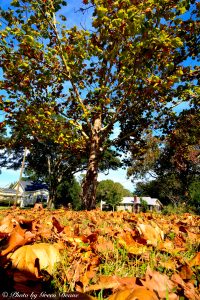
Sycamores drop a lot of leaves.
The largest group of trees you can tap are maples ( Sugar, Black, Red, Silver, Norway, Boxelder, Bigleaf, Canyon, Rocky Mountain, and Gorosoe.) The birches can also be tapped (Paper, Yellow, Black, River, Gray, and European White Birch.) If I remember correctly no native group of Europeans ever tapped them for food until they learned of the practice in North America. Trees in the walnut group can also be tapped: Butternut (my mother’s favorite) Black Walnut, Heartnut, and English Walnut.
There are two outliers which grow locally. One is Hophornbeam or as I called it growing up, Ironwood. It also has edible seeds. The other tappable species is a very common native and ornamental: The Sycamore. It takes about four to five times more Sycamore sap to get a gallon of syrup than from a Maple. The biggest surprise is that Sycamore Syrup tastes like butterscotch. Processing a natural plant does not always have the outcome you intend. Seagrapes, for example, have a unique taste. Make them into jelly, however, and their originality disappears and they taste like apple jelly. And while birch syrup is a unique and commercial product. It can taste quite similar to molasses. You can read about Sycamores here, Ironwood here.

Ten Global Trends (although there are 78 trends in the book.)
In the book Ten Global Trends there is an article called “Improving Sanitation.” It states regarding human history: “In the rural areas, people lived with their animals, including chickens and cows, and used both animal and human waste to fertilize their crops — an extremely dangerous practice compounded by the fact that people could go throughout much of their lives without ever washing their hands.”

Historically people did not wash their hands.
Never washing your hands… I thought of that as I ate two mangoes with very dirty hands during a foraging class in Port Charlotte last Sunday. I had dug up — with my hands — two yam bubils in an overgrown lot. I strongly advise against digging with your hands not because of germs per se but rather broken glass. A lot of drinkers toss bottles into empty lots and they can give you some horrible cuts. (As can booze bottles in mangrove mud.) In the same area as the bubils are several champagne mango trees that produce a lot of fruit that just rots on the ground. It’s the only time I eat super sweet fruit. So I had two, from off the ground, unwashed, dirty hands and all.

Back yard can also be a litter box.
I grew up on a small farm. We had horses, chickens, ducks, dogs, cats, rabbits and pet squirrels. Moose and deer were a common sight in the barnyard scrimping for grain the hoses dropped. Us kids shoveled and played in a lot of manure… horse and chicken being the prime piles. One time while playing hide and seek under a barn I dropped down so not to be seen and gashed my right knee on a broken bottle in the horse manure pile. I still have the scar. Kids raised on farms, research shows, have less allergies (if they survive.) And I usually eat wild plants without washing them unless they are dusty et cetera. People ask me if I am concerned that animals using the wild as their bathroom. Not really. Urine is usually sterile, degrades quickly, and other matter is broken down fast. Most disease contraction today from scat is toddlers getting parasites from cat dropping in their own back yard. Back yard chickens are not much of an issue either. It takes nine chickens to equal the manure of one dog, and the chicken manure is good side dressing (whereas horse and cow manure is weaker and can be used directly.) Dog manure, like most carnivore manure, is foul.
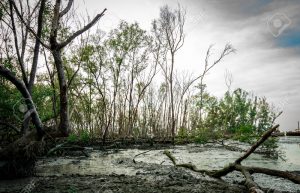
Mangrove Mud can be deep and hide debris.
Thus I am not overly cautious nor overly brave. Soil dirty hands and unwashed mangos fits into that spectrum for me. Two weeks ago I foolishly stepped into mangrove mud to retrieve a lure. I sunk to my knee and what ever stopped me from sinking further left three deep cuts in my heel. (Yes, I had wading shoes, left them in the van. That won’t happen again.) And I had a tetanus shot five years ago after a to-the-bone bite from an injured squirrel that did not want to be rescued (and I’ve had the rabies series as well.) The heel healed without even a minor infection. Apparently the immune system is still working well for 70 and I’m not diabetic.
Another reason to be cautious about vacant lots is you don’t know what was there before its vacancy. I know a nice, green location, that was once a home that burnt to the ground. The soil is black with soot (and who knows what other chemicals.) Not ground for good eating. When I read glowing articles about community gardens growing food on vacant lots in cities I wonder if the lot used to be a car garage or a tanning factory that used all kinds of chemicals. Before I would cultivate a vacant city lot I would do a historical search to find out what used to be at that location.

Classes are held rain or shine or cold. (Hurricanes are an exception.) Photo by Kelly Fagan.
Foraging classes: As you will notice I have a weekend of classes coming up in South Carolina. Two classes each day at Putney Farm in Honea Path. It’s also a chance for me to see two cousins, perhaps for the last time. We are 74, 72, and 70. (The cousin that would be 68 was killed by a drunk driver some 40 years ago.)
Saturday, June 19th, Red Bug Slough Preserve, 5200 Beneva Road, Sarasota, FL, 34233. 9 a.m. to noon.
Sunday, June 20th, Colby-Alderman Park: 1099 Massachusetts Street, Cassadaga. Fla. 32706. 9 a.m. to noon, meet at the bathrooms.
Saturday, June 26th, Eagle Park Lake, 1800 Keene Road, Largo, FL 33771. 9 a.m. to noon, meet at the pavilion near the dog park.
Sunday, June 27th, Blanchard Park, 10501 Jay Blanchard Trail, Orlando, FL 32817. 9 a.m. to noon. Meet beside the tennis courts.
Saturday July 17th, Classes at 9 a.m. and 1 p.m at Putney Farm, 1624 Taylor Rd, Honea Path, SC 29654.
Sunday July 18th, Classes at 9 a.m. and 1 p.m at Putney Farm, 1624 Taylor Rd, Honea Path, SC 29654.
For more information, to prepay or sign up for a class go here.
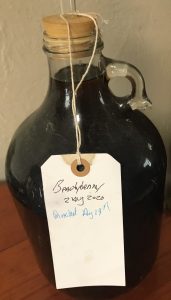
One of two batches of experimental Beautyberry Wine.
Locally the American Beautyberries are blossoming and soon they will have magenta berries. I have about four gallons of Beautyberry Wine working, two different recipes, perhaps ready in a year or two. That said Beautyberries are near the bottom of the list on flavor when eaten out of hand, insipid more than offensive. But they make a great jelly… and perhaps a blush wine. They are not good pie material and in muffins they turn green. The shrub itself has been known for its ability to repel insects. You can read about Beautyberry here .

Green Deane videos are now available on a USB.
150-video USB would be a good spring present and is now $99. My nine-DVD set of 135 videos has been phased out. The USB videos are the same videos I have on You Tube. Some people like to have their own copy. The USB videos have to be copied to your computer to play. If you want to order the USB go to the DVD/USB order button on the top right of this page. That will take you to an order form. I’d like to thank all of you who ordered the DVD set over the years which required me to burn over 5,000 DVDs individually.

Green Deane Forum
Want to identify a plant? Perhaps you’re looking for a foraging reference? You might have a UFO, an Unidentified Flowering Object, you want identified. On the Green Deane Forum we — including Green Deane and others from around the world — chat about foraging all year. And it’s not just about warm-weather plants or just North American flora. Many nations share common weeds so there’s a lot to talk. There’s also more than weeds. The reference section has information for foraging around the world. There are also articles on food preservation, and forgotten skills from making bows to fermenting food. 
Your donations to upgrade the EatTheWeeds website and fund a book were appreciated. A book manuscript has been turned it. It had 425 articles, 1326 plants and a third of a million words. What it will be when the publisher is done with it next year is unknown. It will be published in the spring of 2023. Writing it took a significant chunk of time out of my life from which I have still not recovered. (Many things got put off.) The next phase is to update all the content on the website between now and publication date. Also note as it states above the 135-video DVD set has been phased out for 150-video USB. Times and formats change. Which reminds me I need to revisit many plants and make some new videos.
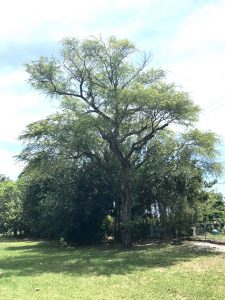
Sweet acacia, Dreher Park. West Palm Beach. Photo by Green Deane
In the works: Sweet Acacia, Vachellia farnesiana (Acacia farnesiana) has mixed reports on edibility, some say yes others say toxic. The tree was pointed out to me during our foraging class Saturday in Dreher Park, West Palm Beach. Cornucopia II, usually reliable, says on page 151 “leaves may be used as a substitute for tamarind in flavoring chutneys. Sprouted seeds are reportedly consumed. the pods are roasted and eaten.” Julia Morton skipped the tree in her “Plants for Survival in South Florida.” Daniel Austin in Florida ethnobotany mentions only herbal applications. The bark is used for tanning leather, and arrow poison, and that the seeds have an alkaoid used to kill dogs in Brazil. James Duke for Perdue University, wrote: “The bark is astringent and demulcent, and along with leaves and roots is used for medicinal purposes. Woody branches used in India as tooth brushes. The gummy roots also chewed for sore throat. Said to be used for alterative, antispasmodic, aphrodisiac, astringent, demulcent, diarrhea, febrifuge, rheumatism, and stimulant (Duke, 1981a). Morton (1981) notes that Guatemalans value the flower infusion as a stomachic. It is also used for dyspepsia and neuroses. Mexicans sprinkle powdered dried leaves onto wounds. The flowers are added to ointment, rubbed on the forehead for headache. Green pods are decocted for dysentery and inflammations of the skin and raucous membranes. Colombians bathe in the bark decoction for typhoid. Costa Ricans decoct rhe gum from the trunk for diarrhea, using the pod infusion for diarrhea, leucorrhea, and uterorrhagia. Panamanians and Cubans used the pod to treat conjunctivitis. Cubans use the pod decoction for sore throat. For rheumatic pains, West Indians bind bark strips to the afflicted joint. The root decoction has been suggested as a folk remedy for tubersulosis.
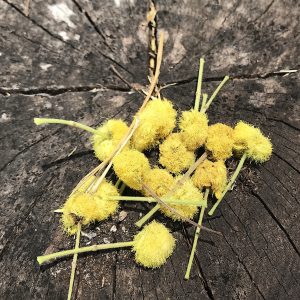
Sweet Acacia blossoms. Photo by Green Deane
“Dried seeds of one Acacia sp. are reported to contain per 100 g: 377 calories, 7.0% moisture, 12.6 g protein, 4.6 g fat, 72.4 g carbohydrate, 9.5 g flber, and 3.4 g ash. Raw leaves of Acacia contain per 100 g: 57 calories, 81.4% moisture, 8.0 g protein, 0.6 g fat, 9.0 g carbohydrate, 5.7 g fiber, 1.0 g ash, 93 mg Ca, 84 mg P, 3.7 mg Fe, 12,255 mg b-carotene equivalent, 0.20 mg thiamine, 0.17 mg riboflavin, 8.5 mg niacin, and 49 mg ascorbic acid. Reporting 55% protein on a dryweight basis, Van Etten et al (1963) break down the amino acids as follows: lysine, 4.7 (g/16 g N); methionine, 0.9; arginine, 9.2; glycine, 3.4;. histidine, 2.3; isoleucine, 3.5; leucine, 7.5; phenylalanine, 3.5; tyrosine, 2.8; threonine, 2.5; valine, 3.9; alanine, 4.3; aspartic acid, 8.8; glutamic acid, 12.6; hydroxyproline, 0.0; proline, 5.1; serine, 4.1; with 76% of the total nitrogen as amino acids. Cassie has been reported to contain anisaldehyde, benzoic acid, benzyl alcohol, butyric acid, coumarin, cresol, cuminaidehyde, decyl aldehyde, eicosane, eugenol, farnesol, geraniol, hydroxyacetophenone, methyleugenol, methyl salicylate, nerolidol, palmitic acid, salicylic acid, and terpineol (Duke, 1981). The leaves contain lipids, carotenoids, alkaloids, and reducing and non-reducing sugars (Morton, 1981). El Sissi et al (1973) isolated and identified from pods, seven polyphenols (gallic acid, ellagic acid, m-digallic acid, methyl gallate, kaempferol, atomadendrin, and narigenin). Also they found narigenin-7-glucoside and naringenin-7-rhamnoglucoside (naringin), as well as naringenin, glucose, and gallic acid.” The flowers are used to make perfume. We also know the seeds have protein-binding lectins. Is the tree edible? Who knows, and is that really the species we saw? Clearly more research is needed.
This is weekly newsletter #461. If you want to subscribe to this free newsletter you can find the sign-up form in the menu at the top of the page.
To donate to the Green Deane Newsletter click here.


I boiled down 20 gallons of birch sap this spring. 3 gallons on a hot plate tasted similar to maple. The remainder on an open fire smelled like honey but ended more like smoked fish.
Forgot to ask, elm sap?
Slippery elm inner bark tastes somewhat like pecan and maple.
Love the stories and commentaries always–a bonus to the immense knowledge you share on wild edibles (and increasingly wild medicinals). And especially love hearing the book is on the horizon! 2 years is a long time to wait–but then, it’s not! “Time flies” is so real at this time of life that I have to try and take deep breaths and focus on today as much as I can!